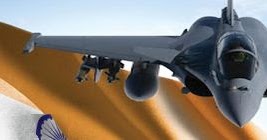HAL BACK ON RAFALE RADAR, TALKS ON FOR MAKING JETS IN INDIA
French aircraft manufacturer Dassault and state-owned Hindustan Aeronautics Limited have worked most recently on $2.1 b deal to upgrade IAF’s Mirage 2000 fleet. General Rawat has spoken of staggered purchases of fighter jets in the future, his idea being that small batches would be ordered to ensure that allocated funds can cover the price
by Manu Pubby
NEW DELHI: French aircraft manufacturer Dassault and state-owned Hindustan Aeronautics Limited (HAL) are in talks for possible cooperation in producing Rafale fighter jets in India for additional anticipated orders under a ‘staggered procurement’ plan.
Sources have told Economic Times that a few rounds of discussions have taken place between the companies on possible work share for additional orders of the cutting edge combat jet, though there is no going back to earlier discussions that broke down in 2012 over differences in localisation and pricing.
The two aviation companies are old partners, having worked most recently on the $2.1 billion deal to upgrade the Indian Air Force’s Mirage 2000 fleet. If additional orders are placed for Rafale — Chief of Defence Staff Gen Bipin Rawat hinted recently that 36 more fighter jets could be ordered within four years — a work share model could be worked out to manufacture parts for the fighter jet at HAL facilities.
At present, French manufacturers are executing the order for 36 jets and investing 50% of the €7.8 billion contract price in the Indian aerospace and defence sectors as part of the offsets clause, with a factory in partnership with Reliance Defence at Nagpur also geared to produce the Falcon executive jets.
While the contours of a possible partnership have not been finalised, sources confirmed that detailed discussions have taken place on how HAL facilities and expertise could be used for the next round of localisation when more jets are ordered.
In several comments over the past weeks, General Rawat has spoken of staggered purchases of fighter jets in the future, his idea being that small batches would be ordered to ensure that allocated funds can cover the price. The top officer also suggested that 36 more Rafales could be ordered in three to four years to make up for gaps in fighter squadron strength.
The current batch of Rafales on order are following the ‘staggered payments’ model, with India paying for 11 fighter jets every year till deliveries end. If the contract is extended, the staggered procurement could stretch over the next few years to make up for fighter shortages.
As reported by ET, an offer is on the table for the sale of two more squadrons, which means 36 additional Rafale jets, for the IAF. While the deal for 36 Rafale jets signed in 2016 cost €7.87 billion, the additional 36 aircraft could cost significantly lower at around €6 billion as fixed costs covering India specific enhancements, training equipment and infrastructure have already been made.
The two airbases that are being created for the Rafales on order are capable of absorbing additional jets without any change, which would also bring down the cost of the deal. If the Rafale jet deal is extended with the ‘staggered order approach’ it could lead to a rethink on earlier plans of acquiring 110 fighter jets under the Strategic Partnership (SP) model that requires an Indian company to tie up with a foreign collaborates to produce the aircraft domestically.
French aircraft manufacturer Dassault and state-owned Hindustan Aeronautics Limited have worked most recently on $2.1 b deal to upgrad...

www.indiandefensenews.in




